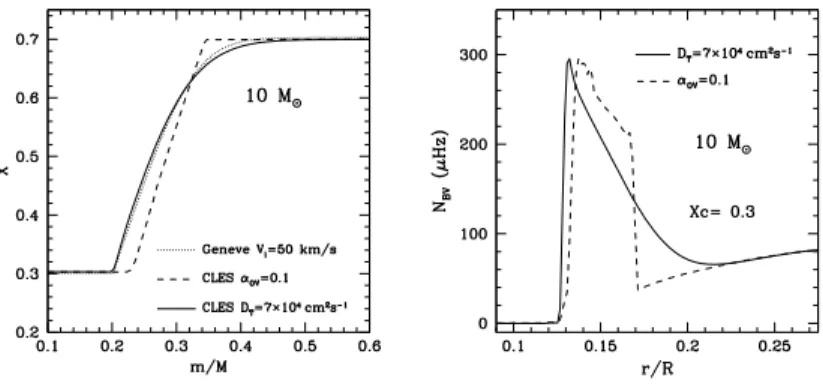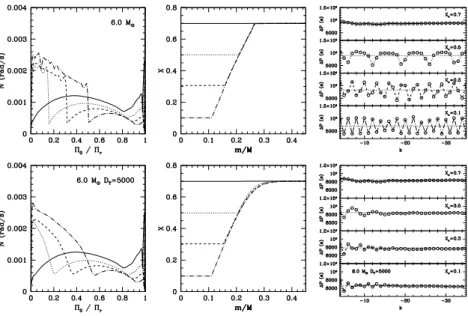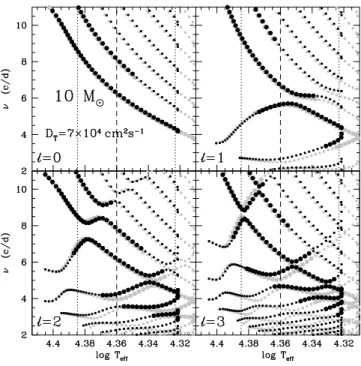arXiv:0901.2045v1 [astro-ph.SR] 14 Jan 2009
Abstract
Chemical turbulent mixing induced by rotation can affect the internal distribution of µ near the energy-generating core of main-sequence stars, having an effect on the evolutionary tracks similar to that of overshooting. However, this mixing also leads to a smoother chemical composition profile near the edge of the convective core, which is reflected in the behavior of the buoyancy frequency and, therefore, in the frequencies of gravity modes. We show that for rotational velocities typical of main-sequence B-type pulsating stars, the signature of a rotationally induced mixing significantly perturbs the spectrum of gravity modes and mixed modes, and can be distinguished from that of overshooting. The cases of high-order gravity modes in Slowly Pulsating B stars and of low-order g modes and mixed modes in β Cephei stars are discussed.
Session: What can asteroseismology do to solve the problems
Introduction
Asteroseismology of main-sequence B-type stars is now providing us with constraints on the structure and on the internal rotation rate of massive stars (see e.g. the recent review by Aerts 2008 ). In particular, evidence for non-rigid rotation and for extra mixing near the core was found in several β Cep pulsators (see e.g. Aerts et al. 2003, Mazumdar et al. 2006, Briquet et al. 2008, Dziembowski & Pamyatnykh 2008 ). In this context, an even deeper insight into the internal structure of B stars could be obtained if the seismic probe provided by the observed oscillation modes is fine enough to differentiate the near-core extra mixing due to overshoot from that induced by rotation.
With the aim of studying the effects of different extra-mixing processes on the frequency spectra of SPB and β Cep pulsators we focus, respectively, on models of 6 and 10 M⊙. We
consider the effect of overshooting and of turbulent mixing near the core that could be induced by the effects of rotation on the transport of chemicals. The models with overshooting were computed with cles (Code Li´egeois d’Evolution Stellaire, Scuflaire et al. 2008 ). In this code the thickness of the overshooting layer ΛOVis parameterized in terms of the local pressure
scale height Hp: ΛOV= αOV×(min(rcc, Hp(rcc)), where rccis the radius of the convective
core given by the Schwarzschild criterion and αOV is a free parameter. In the overshooting
region mixing is assumed to be instantaneous and the temperature stratification radiative. As a first approach, the turbulent mixing has been modelled in cles by a diffusion pro-cess with a parametric turbulent diffusion coefficient DTthat is uniform inside the star and
2 Discriminating between overshooting and rotational mixing in massive stars: any help from asteroseismology?
Figure 1: Left panel: Hydrogen mass fraction profile in the central regions of 10 M⊙models with XC≃ 0.3. The different lines correspond to models computed with cles, with overshooting (dashed line), and turbulent diffusion coefficient DT(solid line), and with the Geneva code with an initial rotational velocity of 50 km s−1 (dotted line). Right panel: Brunt-V¨ais¨ala frequency profile in the central regions of the 10 M⊙clesmodels shown in the left panel.
independent of age. We computed also models using the Geneva code that includes the treat-ment of rotation and related transport processes as described in Eggenberger et al. 2008. The comparison between the two series of models shows that the chemical composition profiles in the central regions provided by a uniform and time independent diffusion coefficient represent a first approximation, at least for massive stars, of the effect that would be produced by such a rotationally induced chemical transport (see Fig. 1). The values of the parameter DTwere chosen in order to be close to the value of the chemical diffusion coefficient near
the core provided by the Geneva models (see Montalb´an et al. 2008 for more details on this parametrization).
SPBs and β Cep pulsators are considered as slow or moderate rotators. SPBs show a typical rotational velocity of 25 km s−1(Briquet et al. 2007 ), whereas the range of projected
rotational velocity in β Cep stars extends from 0 to 300 km s−1with an average of 100 km s−1
(Stankov & Handler 2005 ). The Geneva code calculations for 10 M⊙models provide values
of the chemical diffusion coefficient near the convective core with XC= 0.3, of the order of
5 × 104 cm2s−1 for a rotational velocity on the zero-age main sequence (hereafter named
initial rotational velocity, Vi) of 20 km s−1, 7 × 104 cm2s−1 for Vi=50 km s−1, and 1.6 ×
105
cm2
s−1for V
i=100 km s−1. On the other hand, the effect of an initial rotational velocity
of 25km s−1 on the central hydrogen distribution of a 6 M
⊙ model is well mimicked by a
DT ∼5000 cm2s−1. The results presented in this paper concern mainly the parametric
models with DT= 5 × 103 cm2s−1for SPB models and DT= 7 × 104cm2s−1for β Cep
ones, and they will be compared with overshooting models closely located in the HR diagram, that means αOV=0 for the SPB case and 0.1 for the β Cep one.
As shown in Fig. 1, models located at the same position in the HR diagram, but computed with overshooting or with turbulent mixing, show a significantly different chemical composi-tion profile near the core (see Fig. 1 left panel) and consequently a different behaviour of the sharp feature in the Brunt-V¨ais¨ala frequency (N ) located in the µ-gradient region (Fig. 1 right panel).
Figure 2: Behaviour of the Brunt-V¨ais¨ala frequency (left panels), of the hydrogen abundance profile (middle panels) and of the ℓ = 1 g-mode period spacing in models of 6 M⊙(right panels). We consider several models along the main sequence with decreasing central hydrogen abundance (Xc= 0.7, 0.5, 0.3 and 0.1). In the right panels the uppermost model has Xc= 0.7and the lowermost Xc= 0.1. Upper panels refer to models computed with no extra mixing, whereas lower panels in models of 6.0 M⊙computed with a turbulent diffusion coefficient DT= 5000cm
2 s−1
.
High-order g modes in Slowly Pulsating B stars
As presented in Miglio et al. (2008a) (hereafter Paper I), the periods of high-order gravity modes in main-sequence stars can be related, by means of analytical expressions, to the detailed characteristics of the µ-gradient region that develops near the energy-generating core, and thus to the mixing processes that affect the behaviour of µ in the central regions. The period spacing (∆P ) of high-order g modes can be described as a superposition of a constant term predicted by the first order approximation by Tassoul (1980) and periodic components directly related to the location and sharpness of ∇µ.
We recall that in the asymptotic approximation presented in Tassoul (1980) the periods of high-order gravity modes are given by Pkl= π2Π0L−1(2k + cte), where L = [ℓ(ℓ + 1)]1/2
(with ℓ the mode degree), k the order of the mode and Π−1 0 =
R
1x0 N
x′dx′, where x′is the
normalized radius and x0 corresponds to the boundary of the convective core.
In main-sequence stars ∇µ depends on the size of the convective core and on extra-mixing processes (e.g. overshooting, diffusion, turbulent extra-mixing) that may alter the chemical composition profile in the central region of the star. We here briefly describe the effect of rotationally induced mixing by considering models of a 6 M⊙ star computed including
turbulent diffusion near the core (described by a turbulent-diffusion coefficient DT= 5 × 103
cm2 s−1), which mimics the effects of an initial rotational velocity of 25km s−1. In Fig. 2
we compare the period spacing of such models (lower-right panel) with models that share the same location in the HR diagram, but are computed without any extra-mixing (upper-right
4 Discriminating between overshooting and rotational mixing in massive stars: any help from asteroseismology?
Figure 3: Frequencies of pulsation modes with angular degree ℓ = 0 − 3 as a function of log Teff for main-sequence models of a 10 M⊙ star. Gray dots correspond to the frequencies of models computed with an overshooting parameter αOV= 0.1, whereas black dots are the frequencies of models computed with a turbulent diffusion coefficient DT= 7 × 10
4 cm s−2
. Excited modes are represented by thicker symbols. The vertical lines indicate the effective temperature of models with a hydrogen mass fraction at the center of the order of 0.5, 0.3 and 0.1 (left to right).
panel). We notice that turbulent mixing has a substantial effect on the period spacing: the amplitude of the periodic components in ∆P becomes a decreasing function of the radial order k. This behaviour can be easily explained by the analytical approximation in Paper I, provided that the smoother µ profile (and thus N , see Fig. 2) is taken into account in the analysis.
Low-order g modes and mixed modes in β Cephei stars
As recalled in the previous section, changes of µ induced by the turbulent mixing acting near the core lead to significant variations in the properties of the spectrum of high-order g modes. Although the approximation presented in Paper I and used to relate the sharpness of the “bump” in the Brunt-V¨ais¨ala frequency to the properties of g modes is no longer valid for low-order modes, the analytical description of gravity modes mentioned there is still able to qualitatively relate some properties of low-order g-mode spectra to the characteristics of the µ-gradient region near the core (see Miglio et al. 2008b).
During the main sequence, the combined action of nuclear reactions and convective mixing leads to a chemical composition gradient at the boundary of the convective core, to a decrease of Π0, and thus to an increase of the frequencies of gravity modes. The latter interact with
pressure modes of similar frequency and affect the properties of non-radial oscillations by the so-called avoided-crossing phenomenon. The modes undergoing an avoided crossing (mixed modes) are therefore sensitive probes of the core structure of the star.
As presented in Montalb´an et al. (2008), we describe the effects of extra-mixing on the oscillation spectrum of a typical β Cep star by comparing the properties of low-order g and p modes in models computed with overshooting and with chemical turbulent diffusion. Since the parameters αOV and DT were chosen to lead to similar evolutionary tracks on the HR
diagram, such comparison allows us to remove the differences in the frequencies due to a different stellar radius. In Fig. 3 we plot the oscillation frequencies for 10 M⊙models along
the main-sequence phase. As expected, the differences between frequencies of overshooting models and turbulent mixing ones is very small for pressure modes, while significant differences appear for gravity and mixed modes. These differences increase with the radial order of g modes and, for a given frequency, with the angular degree of the modes. In Fig. 3 we have also marked with thicker symbols the frequencies of modes that the non-adiabatic oscillation code MAD (Dupret et al. 2003 ) predicts to be excited. Here we show only the case with DT = 7 × 104 cm2s−1 but computations with lower or higher efficiency of the turbulent
mixing show that the differences between overshooting and turbulent-mixing models increase with the value of DT.
What is most relevant from an asteroseismic point of view, is the change in the distance between consecutive frequencies of g-modes or modes of mixed p-g character (∆ν). In Fig. 4 we plot these differences for the ℓ = 2 modes of the 10 M⊙models with an effective
temperature Teff ≃22550 K (XC≃0.3). The dots indicate differences computed between
pairs of excited modes. Therefore the difference of ∆ν that we can expect between models with sharp ∇µ(overshooting models for instance) and models with a chemical composition
gradient smoothed by the effect of, for instance, a slow rotation (Vrot ∼ 50 km/s) is of
the order of 0.4 c/d (∼ 5 µHz), much larger than the precision of present and forthcoming observations.
6 Discriminating between overshooting and rotational mixing in massive stars: any help from asteroseismology?
Conclusions
We presented how the frequencies of gravity modes and mixed modes in β Cep and SPB stars depend on the detailed characteristics of the µ-gradient region that develops near the energy generating core, and thus on the mixing processes that can affect the behaviour of µ in the central regions. In particular we have shown that for rotational velocities typical of main-sequence B-type pulsating stars, the signature of a rotationally induced mixing significantly perturbs the spectrum of gravity modes and mixed modes, and can be distinguished from that of overshooting.
Such a sensitivity of g-mode oscillation frequencies to near-core mixing can provide an additional constraint to the modelling of massive stars with rotation, especially when coupled with seismic inferences on the internal rotational profile (see e.g. the review by Goupil & Talon 2009 ), and with constraints on chemical enrichments in the photosphere (e.g. Maeder et al. 2008 and Morel 2008 ). Further investigations are however needed to assess under which observational conditions such information can be recovered from the oscillation frequencies, given realistic uncertainties on stellar global parameters, errors on oscillation frequencies and, in the case of SPBs, given the severe influence of rotation on the spectrum of g modes. Acknowledgments. A.M. and J.M. acknowledge financial support from the Prodex-ESA Contract Prodex 8 COROT (C90199). A.M. is a Charg´e de Recherches of the FRS-FNRS. P.E. is thankful to the Swiss National Science Foundation for support.
References
Aerts, C. 2008, IAUS, 250, 237
Aerts, C., Thoul, A., Daszynska, J. et al. 2003, Science, 300, 1926 Briquet, M., Hubrig, S., De Cat, P. et al. 2007, A&A, 466, 269 Briquet, M., Morel, T., Thoul, A. et al. 2007, MNRAS, 381, 1428 Dupret, M.-A., De Ridder, J., De Cat, P., et al. 2003, A&A, 398, 677 Dziembowski, W., Pamyatnykh, A. 2008, MNRAS, 385, 206 Eggenberger, P., Meynet, G., Maeder, A, et al. 2008, Ap&SS, 316, 43 Goupil, M.J., Talon., S., 2008, CoAst, 158, in press
Maeder, A., Meynet, G., Ekstrom, S., & Georgy, C. 2008, CoAst 158, in press (arXiv:0810.0657) Mazumdar, A., Briquet, M., Desmet, M., & Aerts, C. 2006, A&A, 459, 589
Miglio, A., Montalb´an, J., Noels, A., & Eggenberger, P. 2008a, MNRAS, 386, 1487 Miglio, A., Montalb´an, J., Eggenberger, P., & Noels, A. 2008b, AN, 329, 529 Montalb´an, J., Miglio, A., Eggenberger, P., & Noels, A. 2008, AN, 329, 535 Morel, T. 2008, CoAst, 158, in press (arXiv:0811.4114)
Scuflaire, R., Montalb´an, J., Th´eado, S., et al. 2008, ApSS, 316, 149 Stankov, A., & Handler, G. 2005, ApJS, 158, 193


